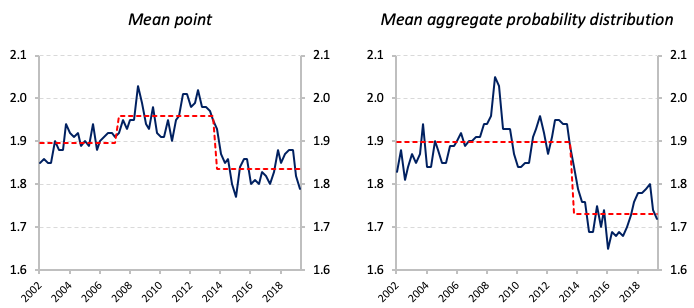The anchoring of inflation expectations is a necessary condition for central banks to maintain price stability, as it prevents temporary shocks to inflation from feeding into the mechanisms of wage and price formation (Bernanke 2007, Draghi 2014). Concerns about the de-anchoring of long-term inflation expectations from the ECB Governing Council’s inflation aim have resurfaced since the beginning of 2019, as market-based indicators have reached new historical lows. The five-year five-year-ahead inflation expectations based on inflation-linked swaps (ILS) reached 1.10% after the June 2019 policy meeting of the Governing Council, 15 basis points below the previous minimum reached in June 2016 (Figure 1, panel A). The five-year ahead expectation in the October 2019 ECB’s Survey of Professional Forecasters was between 1.6 and 1.7% (Figure 1, panel B), depending on the statistical measure. Forecasters have revised downward their long-term expectations in the four rounds between October 2018 and October 2019.
Figure 1 Long-term inflation expectations (per cent)
Source: Bloomberg and ECB.
Note: Panel A shows market-based inflation expectations computed as averages of the yields on ILS over the period in which forecasters were responding to the Survey of Professional Forecasters. Panel B shows the long-term inflation (five-year ahead) expectations from the Survey of Professional Forecasters.
Are long-term inflation expectations anchored to the ECB’s inflation target? In a recent paper (Corsello et al. 2019), we assess the degree of anchoring of long-term inflation expectations in the euro area using the replies to the ECB’s Survey of Professional Forecasters by means of three different methods: (i) a break-point analysis on the level of long-term expectations; (ii) their sensitivity to macroeconomic surprises; and (iii) their sensitivity to movements in short-term inflation expectations. Long-term inflation expectations are anchored if they are in line with the inflation objective of the central bank and they do not respond to either macroeconomic surprises or developments in short-term inflation expectations. In these cases, investors are confident that the central bank can and will react to shocks in order to ensure that inflation returns to the target over the policy-relevant horizon.
Testing the level of anchoring
We apply the sequential procedure developed in Bai and Perron (2003) to detect possible structural changes in different measures of long-term expectations within a univariate setting (Dovern and Kenny 2017).
Figure 2 Testing for level shifts of long-term inflation expectations (per cent)
Source: Authors’ calculations based on the ECB Survey of Professional Forecasters.
Using the mean long-term expectations, we found two breaks. The first occurred in 2007Q2 (Figure 2, panel A), from 1.90% to 1.96%; the second occured in 2013Q3, when long-term expectations shifted downward to 1.84%. The latter shift has not been reversed. The approach applied to the mean of the aggregate probability distribution yields a single break in 2013Q4, when the level shifted downward by 17 basis points, from 1.9% to 1.73%. No breaks are detected using the median forecast. The above results show that the degree of anchoring measured by the level of long-term inflation expectations has weakened with the beginning of disinflation in 2013. Even though the new levels around which expectations have been fluctuating since then may be consistent with the Governing Council’s inflation aim, the lack of a recovery to the levels prevailing before disinflation, notwithstanding the very accommodative monetary policy stance of recent years, suggests that the anchoring of long-term expectations has weakened.
Sensitivity to inflation surprises
To test for significant changes in the sensitivity of long-term expectations to inflation surprises,1 we apply the methodology of Bai and Perron (2003) in a regression where the first differences of long-term inflation expectations depend on the inflation surprises. The analysis finds a significant regime break in the second half of 2013 in the cases of mean and median expectations. The coefficient after the break is larger in the case of median expectations (0.256 compared with 0.142 for the mean ones). The coefficients before the break are not statistically different from zero. Using the mean of the aggregate distribution, no significant regime break is detected. We also provide additional evidence of an asymmetric response to positive and negative surprises. It turns out that the sensitivity of long-term expectations to negative surprises increased sharply in 2013Q3, while the sensitivity to positive surprises is not statistically significant over the whole sample.
Persistently negative surprises can be deemed responsible for the de-anchoring of long-term expectations, which, importantly, does not seem affected by positive surprises. One possible interpretation for this result is that forecasters may have perceived the 2% in the Governing Council’s definition of price stability to be a cap, despite recent clarifications by President Draghi on the symmetry of the inflation aim (Draghi 2019).
Insights from individual forecasters
The Survey of Professional Forecasters allows us to enrich the analysis along two dimensions by exploiting the cross-sectional dimension of the survey. We explore the heterogeneity of individual expectations according to two criteria: (i) the overall respondents’ participation since the beginning of the survey; and (ii) the accuracy in predicting short-term inflation (Nechio 2015). We repeat the previous analyses for each of the identified groups.
While a downward shift in the average level of inflation expectations occurred regardless of the degree of participation in the survey over time, a regime break in the sensitivity to negative surprise is detected only for the most active group, which encompasses forecasters having responded to more than 60 rounds since 2001. This result raises serious concerns regarding the anchoring of long-term inflation expectations. The more active forecasters are likely to have a significant stake in ECB monetary policy, investing time and resources in understanding the rationale for the policy decisions and assessing their adequacy and effectiveness. To the extent that processing all the relevant information is costly, the more a respondent contributes to the Survey of Professional Forecasters, the more valuable her long-term inflation expectation is for assessing the degree of anchoring to the ECB Governing Council’s inflation aim. In a different specification, the results obtained when dividing the sample in two parts depending on the degree of forecast accuracy remain as in the general case. Both groups (more and less accurate forecasters) are characterised by a level shift and an increase in the sensitivity to negative surprises starting in 2013.
Using the same groupings of forecasters, we tested the robustness of our results by studying the sensitivity of long-term inflation expectations to short-term expectations (as in Łyziaka and Paloviita 2017). In this framework, it also turns out that this type of sensitivity, which is generally not significant in the first part of the sample, increases considerably after 2014, especially for the most active group.
The results obtained by grouping the Survey of Professional Forecasters participants are the following. First, the two criteria used to categorise individual forecasters lead to groups that are substantially different. The forecast accuracy criterion does not lead to heterogeneity in the behaviour of aggregate long-term expected inflation between the two groups. On the contrary, the participation criterion identifies groups of forecasters whose long-term expectations show a different degree of anchoring. A good forecasting performance is not a necessary condition for being capable of assessing the anchoring of long-term inflation expectations. Indeed, this assessment requires an in-depth understanding of the ECB’s monetary policy, of the motivations for the undertaken measures, and of their implications for price stability.
Conclusions and policy implications
Our econometric analyses based on the ECB’s Survey of Professional Forecasters show that long-term expectations de-anchored from the Governing Council’s inflation aim after the beginning of disinflation in early 2013. Long-term inflation expectations have become sensitive to negative surprises to inflation. The need to re-anchor long-term inflation expectations to the Governing Council’s aim should be a priority for monetary policy. Re-anchoring expectations is essential for preserving the credibility of the ECB, which is a necessary condition for ensuring the effectiveness of its monetary policy. The current expansionary monetary policy stance contributes to raising long-term inflation expectations to levels close to the Governing Council’s aim.
References
Bai, J and P Perron (2003), “Computation and analysis of multiple structural change models”, Journal of Applied Econometrics 18: 1-22.
Bernanke, B S (2007), “Inflation expectations and inflation forecasting”, speech at the Monetary Economics Workshop of the NBER Summer Institute, Cambridge, Massachusetts.
Corsello, F, S Neri and A Tagliabracci (2019), “Anchored or de-anchored? That is the question”, Banca d’Italia Occasional paper 516.
Dovern, J and G Kenny (2017), “The long-term distribution of expected inflation in the euro area: What has changed since the great recession?”, European Central Bank working paper 1999.
Draghi, M (2014), “Monetary policy in the euro area”, speech at the Frankfurt European Banking Congress, 21 November.
Draghi, M (2019), Press conference, 25th July.
Łyziaka, T and M Paloviita (2017), “Anchoring of inflation expectations in the euro area: Recent evidence based on survey data”, European Journal of Political Economy 46: 52-73.
Nechio, F (2015), “Have long-term inflation expectations declined?”, Federal Reserve Bank of San Francisco Economic Letters 11.
Endnotes
[1] The surprises are measured by the difference between the monthly flash release of the Eurozone Harmonised Index of Consumer Prices year-on-year inflation rate and the corresponding analysts’ median forecast surveyed by Bloomberg a few days before the release. Positive surprises indicate that analysts have under-predicted inflation, and vice versa.








